如何解决WCDMA上下行链路不平衡问题
- 格式:pdf
- 大小:115.78 KB
- 文档页数:3
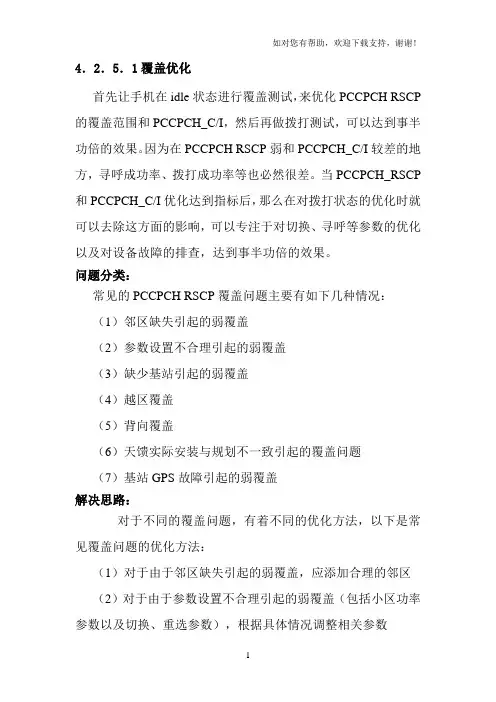
4.2.5.1覆盖优化首先让手机在idle状态进行覆盖测试,来优化PCCPCH RSCP 的覆盖范围和PCCPCH_C/I,然后再做拨打测试,可以达到事半功倍的效果。
因为在PCCPCH RSCP弱和PCCPCH_C/I较差的地方,寻呼成功率、拨打成功率等也必然很差。
当PCCPCH_RSCP 和PCCPCH_C/I优化达到指标后,那么在对拨打状态的优化时就可以去除这方面的影响,可以专注于对切换、寻呼等参数的优化以及对设备故障的排查,达到事半功倍的效果。
问题分类:常见的PCCPCH RSCP覆盖问题主要有如下几种情况:(1)邻区缺失引起的弱覆盖(2)参数设置不合理引起的弱覆盖(3)缺少基站引起的弱覆盖(4)越区覆盖(5)背向覆盖(6)天馈实际安装与规划不一致引起的覆盖问题(7)基站GPS故障引起的弱覆盖解决思路:对于不同的覆盖问题,有着不同的优化方法,以下是常见覆盖问题的优化方法:(1)对于由于邻区缺失引起的弱覆盖,应添加合理的邻区(2)对于由于参数设置不合理引起的弱覆盖(包括小区功率参数以及切换、重选参数),根据具体情况调整相关参数(3)对于由于缺少基站的弱覆盖,应通过在合适点新增基站以提升覆盖(4)对于由于越区覆盖导致的覆盖问题,应通过调整问题小区天馈的方位角/俯仰角或者降低小区发射功率解决,但是降低小区发射功率将影响小区覆盖范围内所欲区域的覆盖情况,不建议此种方法解决越区(5)对于背向覆盖,大部分由于建筑物反射导致,合理调整方位角/下倾角(6)对于天馈安装与规划不一致(包括同一基站小区间天馈接反或者天馈下倾角/方位角不合适等)引起的覆盖问题,应对天馈进行调整(7)对于由于基站GPS故障引起的弱覆盖,应及时上站更换故障模块总结:对于网络中存在的各种覆盖问题,我们应仔细分析并找出问题的根源。
有些问题的现象可能是相似或者相同的,但是问题的根源却有着本质的区别,应采取不同的解决方案。
4.2.5.2切换优化无线网络特有的用户移动性,为了保证用户移动过程中同样享有业务就必须使网络具备正确的切换。
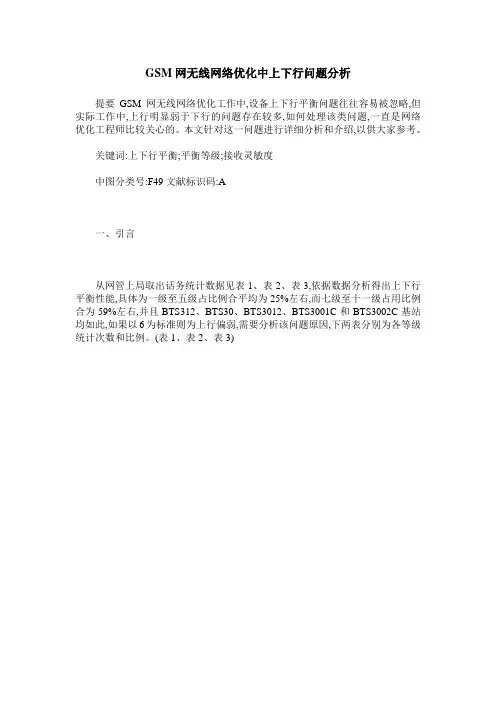
GSM网无线网络优化中上下行问题分析提要GSM网无线网络优化工作中,设备上下行平衡问题往往容易被忽略,但实际工作中,上行明显弱于下行的问题存在较多,如何处理该类问题,一直是网络优化工程师比较关心的。
本文针对这一问题进行详细分析和介绍,以供大家参考。
关键词:上下行平衡;平衡等级;接收灵敏度中图分类号:F49文献标识码:A一、引言从网管上局取出话务统计数据见表1、表2、表3,依据数据分析得出上下行平衡性能,具体为一级至五级占比例合平均为25%左右,而七级至十一级占用比例合为59%左右,并且BTS312、BTS30、BTS3012、BTS3001C和BTS3002C基站均如此,如果以6为标准则为上行偏弱,需要分析该问题原因,下两表分别为各等级统计次数和比例。
(表1、表2、表3)二、问题原因分析按照协议规定,手机的接收灵敏度为-102dBm,而基站接收灵敏度为-110dBm,考虑到一般手机的灵敏度可能会比协议好2dB左右。
所以,一般取手机灵敏度为-104dBm。
这样上下行灵敏度的差别就是6dB。
所以,在上下行平衡的统计项中,当下行接收电平(手机上报)大于上行接收电平(基站上报)6dB时候,我们认为是最理想的平衡状态。
所以,在上下行平衡统计中,等级6就是下行接收电平恰好大于上行接收电平6dB的情况。
表4就是具体的各个统计区间说明。
(表4)上下行平衡话统在BSC侧的计算公式为:下行功率电平-上行功率电平-6dB(灵敏度补偿)=平衡等级上下行不平衡的原因有:(一)基站各个载频中间上报电平有一定的波动。
GSM协议0508规定,测量基站接收机的接收信号电平RMS(均方根值),在正常条件下,从-110dBm~-70dBm,其绝对精度为±4dB,在正常条件和极端温度下,从-110dBm~-48dBm之间,绝对精度为±6dB。
GSM协议这样的规定是从三方面考虑:(1)射频器件的幅频特性(也就是随着频率的变化,射频器件的增益会有些变化,这是射频器件的特性);(2)整个接收通道器件的增益离散性;(3)这种上报精度是不会影响网络指标的。
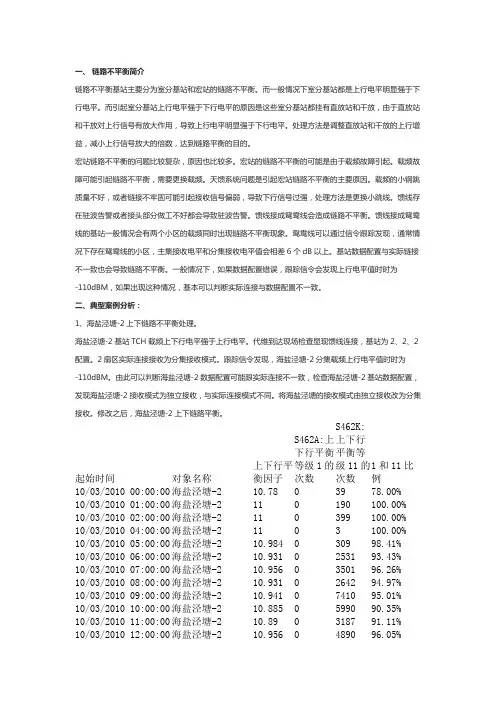
一、链路不平衡简介链路不平衡基站主要分为室分基站和宏站的链路不平衡。
而一般情况下室分基站都是上行电平明显强于下行电平。
而引起室分基站上行电平强于下行电平的原因是这些室分基站都挂有直放站和干放,由于直放站和干放对上行信号有放大作用,导致上行电平明显强于下行电平。
处理方法是调整直放站和干放的上行增益,减小上行信号放大的倍数,达到链路平衡的目的。
宏站链路不平衡的问题比较复杂,原因也比较多。
宏站的链路不平衡的可能是由于载频故障引起。
载频故障可能引起链路不平衡,需要更换载频。
天馈系统问题是引起宏站链路不平衡的主要原因。
载频的小钢跳质量不好,或者链接不牢固可能引起接收信号偏弱,导致下行信号过强,处理方法是更换小跳线。
馈线存在驻波告警或者接头部分做工不好都会导致驻波告警。
馈线接成鸳鸯线会造成链路不平衡。
馈线接成鸳鸯线的基站一般情况会有两个小区的载频同时出现链路不平衡现象。
鸳鸯线可以通过信令跟踪发现,通常情况下存在鸳鸯线的小区,主集接收电平和分集接收电平值会相差6个dB以上。
基站数据配置与实际链接不一致也会导致链路不平衡。
一般情况下,如果数据配置错误,跟踪信令会发现上行电平值时时为-110dBM,如果出现这种情况,基本可以判断实际连接与数据配置不一致。
二、典型案例分析:1、海盐泾塘-2上下链路不平衡处理。
海盐泾塘-2基站TCH载频上下行电平强于上行电平。
代维到达现场检查显现馈线连接,基站为2、2、2配置。
2扇区实际连接接收为分集接收模式。
跟踪信令发现,海盐泾塘-2分集载频上行电平值时时为-110dBM。
由此可以判断海盐泾塘-2数据配置可能跟实际连接不一致,检查海盐泾塘-2基站数据配置,发现海盐泾塘-2接收模式为独立接收,与实际连接模式不同。
将海盐泾塘的接收模式由独立接收改为分集接收。
修改之后,海盐泾塘-2上下链路平衡。
起始时间对象名称上下行平衡因子S462A:上下行平衡等级1的次数S462K:上下行平衡等级11的次数1和11比例10/03/2010 00:00:00 海盐泾塘-2 10.78 0 39 78.00% 10/03/2010 01:00:00 海盐泾塘-2 11 0 190 100.00% 10/03/2010 02:00:00 海盐泾塘-2 11 0 399 100.00% 10/03/2010 04:00:00 海盐泾塘-2 11 0 3 100.00% 10/03/2010 05:00:00 海盐泾塘-2 10.984 0 309 98.41% 10/03/2010 06:00:00 海盐泾塘-2 10.931 0 2531 93.43% 10/03/2010 07:00:00 海盐泾塘-2 10.956 0 3501 96.26% 10/03/2010 08:00:00 海盐泾塘-2 10.931 0 2642 94.97% 10/03/2010 09:00:00 海盐泾塘-2 10.941 0 7410 95.01% 10/03/2010 10:00:00 海盐泾塘-2 10.885 0 5990 90.35% 10/03/2010 11:00:00 海盐泾塘-2 10.89 0 3187 91.11% 10/03/2010 12:00:00 海盐泾塘-2 10.956 0 4890 96.05%10/03/2010 13:00:00 海盐泾塘-2 10.984 0 62 98.41%10/03/2010 14:00:00 海盐泾塘-2 11 0 389 100.00% 10/03/2010 15:00:00 海盐泾塘-2 11 0 1531 100.00% 10/03/2010 16:00:00 海盐泾塘-2 7.275 13 273 5.73%10/03/2010 17:00:00 海盐泾塘-2 6.585 31 36 1.36%10/03/2010 18:00:00 海盐泾塘-2 6.537 43 398 4.88%10/03/2010 19:00:00 海盐泾塘-2 6.676 19 242 2.69%10/03/2010 20:00:00 海盐泾塘-2 7.521 1 268 2.75%10/03/2010 21:00:00 海盐泾塘-2 6.905 39 179 2.48%10/03/2010 22:00:00 海盐泾塘-2 4.723 185 1 7.23%10/03/2010 23:00:00 海盐泾塘-2 7.605 1 40 3.13%11/03/2010 00:00:00 海盐泾塘-2 7.214 0 0 0.00%11/03/2010 01:00:00 海盐泾塘-2 7.763 0 0 0.00%11/03/2010 03:00:00 海盐泾塘-2 6.646 0 0 0.00%11/03/2010 04:00:00 海盐泾塘-2 7.28 0 0 0.00%11/03/2010 05:00:00 海盐泾塘-2 8.547 4 39 6.83%11/03/2010 06:00:00 海盐泾塘-2 7.329 0 5 0.80%11/03/2010 07:00:00 海盐泾塘-2 6.821 11 58 1.99%11/03/2010 08:00:00 海盐泾塘-2 6.657 6 27 1.15%11/03/2010 09:00:00 海盐泾塘-2 6.91 11 25 0.95%11/03/2010 10:00:00 海盐泾塘-2 6.004 22 183 1.91%11/03/2010 11:00:00 海盐泾塘-2 7.197 11 66 0.84%11/03/2010 12:00:00 海盐泾塘-2 5.697 15 17 0.95%11/03/2010 13:00:00 海盐泾塘-2 5.095 10 1 0.42%11/03/2010 14:00:00 海盐泾塘-2 4.794 48 5 1.77%11/03/2010 15:00:00 海盐泾塘-2 5.359 89 8 1.17%11/03/2010 16:00:00 海盐泾塘-2 4.994 132 15 4.72%2、海盐香溢大酒店上下链路处理。
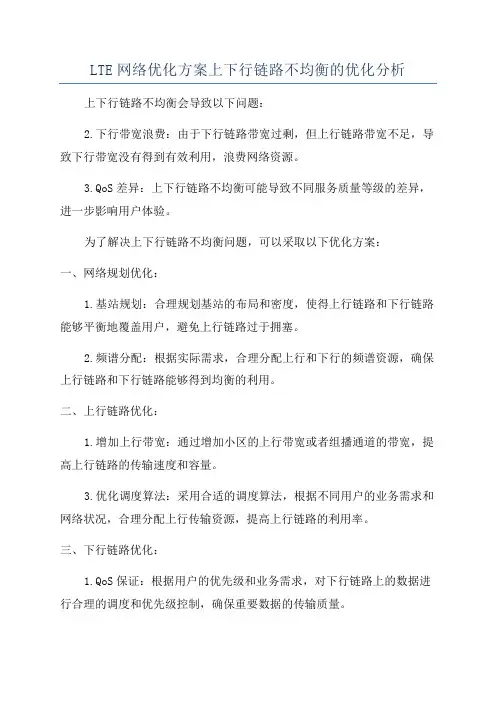
LTE网络优化方案上下行链路不均衡的优化分析
上下行链路不均衡会导致以下问题:
2.下行带宽浪费:由于下行链路带宽过剩,但上行链路带宽不足,导致下行带宽没有得到有效利用,浪费网络资源。
3.QoS差异:上下行链路不均衡可能导致不同服务质量等级的差异,进一步影响用户体验。
为了解决上下行链路不均衡问题,可以采取以下优化方案:
一、网络规划优化:
1.基站规划:合理规划基站的布局和密度,使得上行链路和下行链路能够平衡地覆盖用户,避免上行链路过于拥塞。
2.频谱分配:根据实际需求,合理分配上行和下行的频谱资源,确保上行链路和下行链路能够得到均衡的利用。
二、上行链路优化:
1.增加上行带宽:通过增加小区的上行带宽或者组播通道的带宽,提高上行链路的传输速度和容量。
3.优化调度算法:采用合适的调度算法,根据不同用户的业务需求和网络状况,合理分配上行传输资源,提高上行链路的利用率。
三、下行链路优化:
1.QoS保证:根据用户的优先级和业务需求,对下行链路上的数据进行合理的调度和优先级控制,确保重要数据的传输质量。
2.缓存技术:使用缓存技术对热门数据进行缓存,减少对下行链路的
请求,提高用户对数据的响应速度。
3.增加下行带宽:根据网络负载和用户需求,增加下行链路的带宽,
提高传输速度和容量。
四、终端优化:
1.充分利用终端设备的资源:通过优化终端设备的协议栈和传输机制,减少协议开销,提高上行链路的利用率。
2.功率控制:根据终端设备的信号质量和覆盖范围,合理控制终端设
备的功率,确保信号的质量和传输的稳定性。
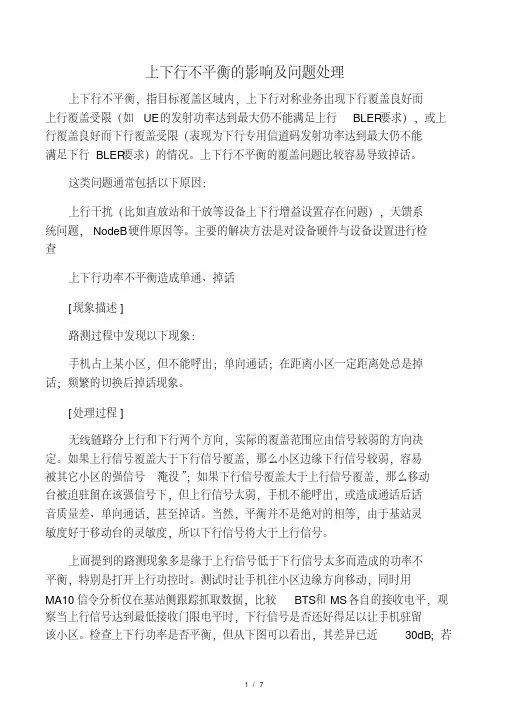
上下行不平衡的影响及问题处理上下行不平衡,指目标覆盖区域内,上下行对称业务出现下行覆盖良好而上行覆盖受限(如UE的发射功率达到最大仍不能满足上行BLER要求),或上行覆盖良好而下行覆盖受限(表现为下行专用信道码发射功率达到最大仍不能满足下行BLER要求)的情况。
上下行不平衡的覆盖问题比较容易导致掉话。
这类问题通常包括以下原因:上行干扰(比如直放站和干放等设备上下行增益设置存在问题),天馈系统问题,NodeB硬件原因等。
主要的解决方法是对设备硬件与设备设置进行检查上下行功率不平衡造成单通、掉话[现象描述]路测过程中发现以下现象:手机占上某小区,但不能呼出;单向通话;在距离小区一定距离处总是掉话;频繁的切换后掉话现象。
[处理过程]无线链路分上行和下行两个方向,实际的覆盖范围应由信号较弱的方向决定。
如果上行信号覆盖大于下行信号覆盖,那么小区边缘下行信号较弱,容易被其它小区的强信号“淹没”;如果下行信号覆盖大于上行信号覆盖,那么移动台被迫驻留在该强信号下,但上行信号太弱,手机不能呼出,或造成通话后话音质量差、单向通话,甚至掉话。
当然,平衡并不是绝对的相等,由于基站灵敏度好于移动台的灵敏度,所以下行信号将大于上行信号。
上面提到的路测现象多是缘于上行信号低于下行信号太多而造成的功率不平衡,特别是打开上行功控时。
测试时让手机往小区边缘方向移动,同时用MA10信令分析仪在基站侧跟踪抓取数据,比较BTS和MS各自的接收电平,观察当上行信号达到最低接收门限电平时,下行信号是否还好得足以让手机驻留该小区。
检查上下行功率是否平衡,但从下图可以看出,其差异已近30dB;若出现多个这样的测量结果,肯定是上行接收存在问题,需要检查TRX板、分路器、塔放电流和天馈的驻波比。
当上行功控打开时,功控参数设置不当也会造成明显的功率不平衡。
首先应保证手机静态功率等级设置正确(900为等级5,1800为等级0),曾发现1800手机因上下行功率不平衡造成单通。

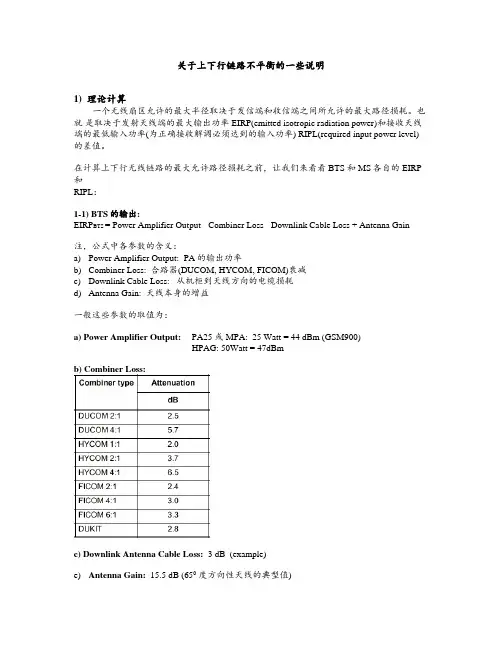
关于上下行链路不平衡的一些说明1) 理论计算一个无线扇区允许的最大半径取决于发信端和收信端之间所允许的最大路径损耗。
也就是取决于发射天线端的最大输出功率EIRP(emitted isotropic radiation power)和接收天线端的最低输入功率(为正确接收解调必须达到的输入功率) RIPL(required input power level) 的差值。
在计算上下行无线链路的最大允许路径损耗之前,让我们来看看BTS和MS各自的EIRP 和RIPL:1-1) BTS的输出:EIRP BTS = Power Amplifier Output - Combiner Loss - Downlink Cable Loss + Antenna Gain注,公式中各参数的含义:a)Power Amplifier Output: PA的输出功率b)Combiner Loss: 合路器(DUCOM, HYCOM, FICOM)衰减c)Downlink Cable Loss: 从机柜到天线方向的电缆损耗d)Antenna Gain: 天线本身的增益一般这些参数的取值为:a) Power Amplifier Output:PA25 或 MPA: 25 Watt = 44 dBm (GSM900)HPAG: 50Watt = 47dBmb) Combiner Loss:c) Downlink Antenna Cable Loss: 3 dB (example)e)Antenna Gain: 15.5 dB (650度方向性天线的典型值)南宁市区天线天线为15.5 dBi郊区为17dBi1-2) MS的输出:手机的电缆损耗(cable loss)和天线增益(antenna gain)都为0。
手机的最大输出功率取决于它的功率等级:摘自 GSM: 05.05通常我们的900兆无线扇区都是为 Power Class=4 (输出功率为33dBm)的手机设计的,但考虑到要保证网内可能还存在的Power Class为2或3的手机的上下行平衡,我们在BSC 数据库中设置:MSTXPMAX=5 (33dBm)。
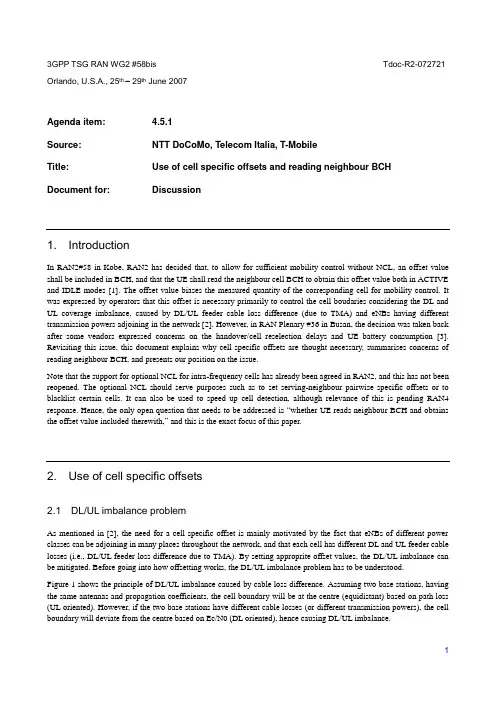
3GPP TSG RAN WG2 #58bis Tdoc-R2-072721 Orlando, U.S.A., 25th – 29th June 2007Agenda item: 4.5.1Source: NTT DoCoMo, Telecom Italia, T-MobileTitle: Use of cell specific offsets and reading neighbour BCHDocument for: Discussion1. IntroductionIn RAN2#58 in Kobe, RAN2 has decided that, to allow for sufficient mobility control without NCL, an offset value shall be included in BCH, and that the UE shall read the neighbour cell BCH to obtain this offset value both in ACTIVE and IDLE modes [1]. The offset value biases the measured quantity of the corresponding cell for mobility control. It was expressed by operators that this offset is necessary primarily to control the cell boudaries considering the DL and UL coverage imbalance, caused by DL/UL feeder cable loss difference (due to TMA) and eNBs having different transmission powers adjoining in the network [2]. However, in RAN Plenary #36 in Busan, the decision was taken back after some vendors expressed concerns on the handover/cell reselection delays and UE battery consumption [3]. Revisiting this issue, this document explains why cell specific offsets are thought necessary, summarises concerns of reading neighbour BCH, and presents our position on the issue.Note that the support for optional NCL for intra-frequency cells has already been agreed in RAN2, and this has not been reopened. The optional NCL should serve purposes such as to set serving-neighbour pairwise specific offsets or to blacklist certain cells. It can also be used to speed up cell detection, although relevance of this is pending RAN4 response. Hence, the only open question that needs to be addressed is “whether UE reads neighbour BCH and obtains the offset value included therewith,” and this is the exact focus of this paper.2. Use of cell specific offsets2.1 DL/UL imbalance problemAs mentioned in [2], the need for a cell specific offset is mainly motivated by the fact that eNBs of different power classes can be adjoining in many places throughout the network, and that each cell has different DL and UL feeder cable losses (i.e., DL/UL feeder loss difference due to TMA). By setting approprite offset values, the DL/UL imbalance can be mitigated. Before going into how offsetting works, the DL/UL imbalance problem has to be understood.Figure 1 shows the principle of DL/UL imbalance caused by cable loss difference. Assuming two base stations, having the same antennas and propagation coefficients, the cell boundary will be at the centre (equidistant) based on path loss (UL oriented). However, if the two base stations have different cable losses (or different transmission powers), the cell boundary will deviate from the centre based on Ec/N0 (DL oriented), hence causing DL/UL imbalance.Fig. 1 DL/UL imbalance principle.2.2 Mitigating DL/UL imbalanceThe DL/UL imbalance problem can be mitigated/tolerated in a number of ways:Alt.1: Mobility control based on Ec/N0 (do nothing)Alt.2: Adjust DL total transmission power based on the UL coverage (DL/UL balancing)Alt.3: Adjust DL pilot transmission power based on the UL coverageAlt.4: Use cell specific offsetsEach solution is described in detail in the sequel. Note that these solutions are not exclusive, and can be combined if so desired.To simplify the discussion, the traffic distribution aspect is omitted for the qualitative assessment below. However in practice, cell planning has to take into account real traffic distributions, which can be far from ideal uniform. It should be noted that this adds another dimension to network planning, which can be quite complicated.2.2.1 Alt.1: Ec/N0 based mobility control (do nothing)The first solution is to do nothing special, and just rely on Ec/N0 to control mobility (Fig.2). This can be optimum for the DL, however, the UL will deteriorate especially at cell edge. If the UE has sufficient transmission power (typ. small cells), it will transmit at a larger power to satisfy its QoS (i.e., the required SIR for a desired rate). If the UE did not have enough power (typ. large cells), the likely consequence in a scheduler based system as in LTE is that it transmits (is scheduled) more frequently so that the desired rate can be met. In either case, this will create larger interference at the neighbour cell, and hence decreases system capacity in the UL.Fig. 2 Ec/N0 based mobility control (do nothing).2.2.2 Alt.2: DL total Tx power adjusting (balancing)The second solution is to adjust the total DL transmission power of the base station such that the DL boundary matches the UL boundary, while the power ratio of the pilot symbols used for mobility measurements is maintained. An example case is shown in Fig. 3. The total power of the base station having a smaller cable loss is reduced, such that the emitted power from the antenna is equal to that of the neighbour having a larger cable loss. This will balance the DL/UL boundaries, hence resolving imbalance, and will be the optimum in terms of the UL. This has a benefit in that it limits DL interference at the neighbour, and generally improves Ior/(Ioc+N0) at cell boundaries. However, it has some drawbacks as the cell with the reduced power now has limited capacity due to reduced power. It may also reduce channel estimation and cell detection performances due to reduced pilot power. This will be more evident in noise limited deployements (e.g., large cells).Fig. 3 DL total Tx power adjusting (balancing).2.2.3 Alt.3: DL pilot Tx power adjustingInstead of adjusting the total transmission power, the transmission power of the pilot symbols can be reduced, while maintaining the total power (Fig. 4). This would also resolve DL/UL imbalance. Since the total power is maintained and data transmissions can be allocated larger powers, the cell can provide larger capacity compared to Alt.2. However, this will create larger interference at the neighbour cell, and will reduce channel estimation and cell detection performance due to reduced pilot power. This alternative will also require some further adjustments e.g.,The transmission powers of other DL common channels (such as BCH) also need to be adjusted considering the channel estimation quality.The pilot/data symbol power ratio must be adjusted and signalled to the UE so that it can correctly demodulate 16QAM or 64QAM signals.These adjustments will have to be performed for each cell, which can incur extensive efforts on operators.Fig. 4 DL pilot Tx power adjusting.2.2.4 Alt.4: Use cell specific offsetsAnother alternative is to use cell specific offsets (Fig. 5). With this alternative, the total and pilot powers do not have to be modified, and the DL/UL imbalance can be mitigated by instead, setting a cell specific offset at each cell. The offset value can be set such that it reflects the cable loss (DL/UL difference). By having the UE take into account the offset value in making mobility decisions, the imbalance can be resolved.The offset can be used to optimise cell boundary for the UL, DL, or anywhere in between, by setting the appropriate offset value. If the offset is used to optimise boundary for the UL, for the cell transmitting at a higher power (left in Fig.5) the DL quality/capacity improves (1), however, the neighbour cell (right in Fig.5) will suffer degraded DL quality/capacity (2) and degraded DL common channel (CCH) quality (3). Note that if the cell boundary is optimised for the DL (offset = 0), the performance will be the same as for Alt.1.Since the pilot power is not reduced as in Alt.3, the channel estimation quality does not degrade with this alternative. The pilot power is usually adjusted considering the optimum (tradeoff) allocation between the pilot and data, and in that sense, this alternative allows to maintain the optimum power allocation settings (i.e., it should not require power adjustments per cell). Although signalling of the offsets incur some additional overhead, this overhead can be trivial considering the entire system bandwidth. As such, it offers a considerably simpler solution to resolving DL/UL imbalance, especially if the offset is read from the neighbour BCH.Fig. 5 DL/UL imbalance mitigation by use of cell specific offsets.2.2.5 Qualitative comparisonTable 1 summarises qualitative comparison of the four alternatives.Table 1 Qualitative comparison.2.2.6 Capacity comparisonHere, two extreme scenarios, i.e., Alt.2 (balancing, hereafter) and Alt.4 (offsetting, hereafter), both optimised for UL,are compared. Note that Alt.3 is expected to perform somewhat similarly as Alt.4, although any difference cannot be assessed without detailed analysis. (It can be expected that Alt.3 performs worse due to poorer channel estimation quality.) The deployment Cases 1 (ISD = 500 m) and 3 (ISD = 1,732 m) in TR 25.814 [4] are assumed, with vertical antenna patterns and tilting also taken into account. The feeder cable loss was modelled as log-normal with [-5 dB, +5 dB] limits, with the sectors of the same eNB having the same cable loss. The log-normal std. deviation was set in a range 1-4 dB, and the median was set such that the resulting gain on average is equal to that assumed in Cases 1 and 3. Snapshot system level simulations were performed to obtain the Ior/(Ioc+N0) distribution, and from this, the normalised capacity was derived considering two factors: CCH overhead according to the Ior/(Ioc+N0) at 2% coverage, and DL-SCH capacity scaling according to the average Ior/(Ioc+N0). For the CCH factor, it was assumed that a 2 dB degradation in Ior/(Ioc+N0) incurs a 3 dB larger overhead for CCH (based on our internal analysis).Figures 6 and 7 compare the Ior/(Ioc+N0) distribution of offsetting (Alt.4) and balancing (Alt.2). It can be observed that offsetting produces worse Ior/(Ioc+N0) in Case 1 (Fig. 6(a), 7(a)). This is due to increased interference at cell edge. However, in Case 3, offsetting produces better Ior/(Ioc+N0) even at around cell edge (Fig. 6(b), 7(b)). This is because balancing (Alt.2) reduces the total transmission power and increases the impact of thermal noise throughout the entire cell.00.20.40.60.81Ior/(Ioc+N0) [dB]00.20.40.60.81Ior/(Ioc+N0) [dB](a) (b)Fig. 6 Ior/(Ioc+N0) distribution for (a) Case 1 and (b) Case 3.Ior/(Ioc+N0) [dB]00.020.040.060.080.1Ior/(Ioc+N0) [dB](a) (b)Fig. 7 Ior/(Ioc+N0) distribution (cell edge) for (a) Case 1 and (b) Case 3.Figure 8 compares the system capacity. As shown in Fig. 8(a), offsetting provides less capacity in Case 1 when some CCH overhead is considered. This is mainly due to the larger CCH overhead caused by Ior/(Ioc+N0) degradation at around cell edge. However, as shown in Fig. 8(b), offsetting provides larger capacity than balancing in Case 3. The capacity is about 20% larger at 2 dB imbalance and 10% CCH overhead. This is because balancing reduces the total power and hence increases the impact of thermal noise. With offsetting, the impact of thermal noise is kept at minimum. Therefore, offsetting is beneficial in providing larger capacity in moderate/large cell scenarios (more evident in thermal noise limited scenarios).Log-normal std. dev. of DL/UL imbalance [dB]Log-normal std. dev. of DL/UL imbalance [dB](a) (b)Fig. 8 Normalised capacity for (a) Case 1 and (b) Case 3.2.2.7 Benefits of cell specific offsetsSummarising above discussions and analysis, the benefits of cell specific offsets are:Offsetting provides larger system capacity when cell size is moderate/large (i.e., more evident in thermal noise limited scenarios);Offsetting allows the operator to flexibly choose between UL optimised and DL optimised;Easy to operate as the offset is just a parameter on BCCH (or DCCH), and does not involve complicated power adjustments.Note that balancing by DL transmission power adjusting is anyway possible, regardless of support for an offset mechanism. The mechanism to utilise cell specific offsets allows the operator to cope with DL/UL imbalance in various ways, providing flexible countermeasures depending on the deployment scenario. Without the offsetting mechanism, the operator is restricted to either tolerating UL losses, or to engage a complicated process of adjusting DL transmission powers. Therefore, the offsetting mechanism should be supported in LTE.3. Reading neighbour BCH3.1 Ways of signalling cell specific offsetsIn section 2, the need for cell specific offsets has been justified. The question then becomes how the offset values are signalled to the UE. As discussed in [2], there are two ways:Alt.1: UE reads offset included in neighbour BCH-The offset is set for its own cell in BCH (no need to care about neighbours).-The same offset applies to all the neighbouring cells (1-to-all).-The UE has to read the neighbour BCH to avoid any ping-pongs [5].-This was decided as mandatory in RAN2#58 in Kobe, but reopened in RAN Plenary #36.Alt.2: Use NCL-The offsets applicable to the relevant neighbours are broadcast by NCL.-The offset can be specific to certain serving-neighbour relationship (1-to-1).-The use of NCL causes larger overhead compared to Alt.1.-NCL needs to be planned and set by OAM, which can be complicated.-This is already supported optionally in LTE (RAN2 decision).The only question that needs to be addressed is whether LTE shall support Alt.1 or not.3.2 Concerns of reading neighbour BCHAs discussed in detail in [2] and above in section 2, the offset can be used primarily to mitigate DL/UL imbalance. As such it is prevalent that each cell requires a different offset value, and that it is sufficient for most cases if the offset is 1-to-all. That is, the 1-to-1 granularity is not necessary to cope with DL/UL imbalance, but only necessary in irregular cases like tunnels. Hence, it would be preferable, from OAM aspects, that Alt.1 is adopted. However, as expressed by [2] and in particular [3], there are several concerns of mandating the UE to read neighbour BCH:UE will have to read BCH for each cell detected;-It can be battery consuming if the UE cannot decode BCH and repeatedly tries decoding for a detected cell;-This problem is more evident if the BCH error rate does not match (is worse than) the cell detection performance;Note: This may be prevented to some extent by specifying UE behaviours, e.g., UE only reads BCH if RSRP > threshold, and/or UE considers offset = 0 if it fails reading BCH after some attempts.UE implementation may be more complex.-UE may have to decide whether to read BCH or not upon detecting a cell, e.g., UE does not have to read for cells indicated in NCL or if RSRP < threshold, etc.Larger BCH overhead to make it robust.- E.g., by reducing the coding rate, increasing Tx power, repetition, soft combining, etc.These aspects need to be discussed in RAN WGs, and comments from UE vendors are especially valuable in this respect. If these concerns are serious, LTE should certainly not support reading of neighbour BCH.3.3 Other aspects of reading neighbour BCHIn discussing the pros/cons of reading neighbour BCH, another aspect that might be worth considering is the CSG cell (home-eNB) scenario. The requirements of CSG cells [6] state notably:7.It shall be possible to minimise the quantity of measurements which UEs perform on CSG Cells, if the UEdoes not belong to the User Group of a specificCSG Cell.8.The mobility procedures shall allow a large number of (small) CSG Cells to be deployed within the coverageof e-UTRAN, UTRAN and GERAN macro-layer cells. Deployment of (additional) CSG Cells shall not require reconfiguration of other eNodeB (E-UTRAN) or RNC (UTRAN) or BSS (GERAN).This could be easily achieved if the UE reads the BCH of a detected cell, and finds out that the cell is not open to public through some simple indicators or cell id included in BCH. This will allow the UE to omit measurements on that cell, and avoid reporting on CSG cells that it has no access to. If the UE does not read neighbour BCH, other means must be thought of, although approaches such as blacklisting seems to contradict with requirement #8 above.4. ConclusionsThe need for cell specific offset mechanism and concerns of reading neighbour BCH have been discussed. Following the discussions above and in [2], we see only two viable alternatives shown in Table 2.Table 2. Viable alternatives [2].After revisiting the issue, our current position is as below:An offset mechanism is necessary.The current RAN2 WA to support optional NCL to set serving-neighbour pairwise specific offsets should be kept.The optional NCL should also be supported for inter-frequency/RA T neighbour cells [2].The solutions for ACTIVE/IDLE mobility should be aligned [2], i.e., the choice should only be between Alt.1 and Alt.2 in Table 2.If reading of neighbour BCH has serious impacts on UE complexity/battery and system performance, Alt.2 in Table 2 should be adopted. Otherwise Alt.1 should be adopted.To progress this issue and reach a firm decision in Orlando, we propose the following way forward:RAN4 should discuss this issue first and provide to RAN2 during the Orlando meeting a consolidated view on reading of neighbour BCH.The final decision shall be made during RAN2#58bis in Orlando, taking into account the comments received from RAN4, and the decision shall be informed to RAN1 and RAN4.References[1] R2-072188, “LS on neighbour cell lists and reading of neighbour cell P-BCH,” RAN WG2.[2] R2-072010, “Operator’s view on neighbour cell information,” NTT DoCoMo, V odafone, Telecom Italia, T-Mobile,Orange.[3] RP-070464, “LTE mobility consideration,” Nokia, Nokia Siemens Networks.[4] TR 25.814, “Physical layer aspects for E-UTRA,” V7.1.0.[5] R2-071296, “Consideration on 1-to-all Qoffset,” NTT DoCoMo, Inc.[6] R2-072139, “Report of email discussion on Home-eNB requirement (point 8),” V odafone Group.。
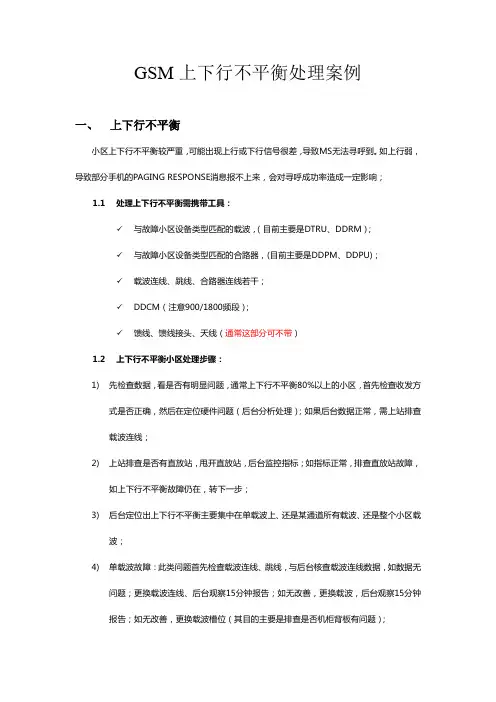
GSM上下行不平衡处理案例一、上下行不平衡小区上下行不平衡较严重,可能出现上行或下行信号很差,导致MS无法寻呼到。
如上行弱,导致部分手机的PAGING RESPONSE消息报不上来,会对寻呼成功率造成一定影响;1.1处理上下行不平衡需携带工具:✓与故障小区设备类型匹配的载波,(目前主要是DTRU、DDRM);✓与故障小区设备类型匹配的合路器,(目前主要是DDPM、DDPU);✓载波连线、跳线、合路器连线若干;✓DDCM(注意900/1800频段);✓馈线、馈线接头、天线(通常这部分可不带)1.2上下行不平衡小区处理步骤:1)先检查数据,看是否有明显问题,通常上下行不平衡80%以上的小区,首先检查收发方式是否正确,然后在定位硬件问题(后台分析处理);如果后台数据正常,需上站排查载波连线;2)上站排查是否有直放站,甩开直放站,后台监控指标;如指标正常,排查直放站故障,如上下行不平衡故障仍在,转下一步;3)后台定位出上下行不平衡主要集中在单载波上、还是某通道所有载波、还是整个小区载波;4)单载波故障:此类问题首先检查载波连线、跳线,与后台核查载波连线数据,如数据无问题;更换载波连线、后台观察15分钟报告;如无改善,更换载波,后台观察15分钟报告;如无改善,更换载波槽位(其目的主要是排查是否机柜背板有问题);5)某通道所有载波故障:此类问题首先明确合路器AB通道下的某个通道有问题,首先检查问题通道下是否有DDCM;1、如果有DDCM且是4载波耦合,更换DDCM,后台观察15分钟报告;如无改善,更换DDPU;如无改善,将小区下AB通道载波互倒换,观察问题载波是否跟随通道变换,如跟随通道变换更换载波即可;2、如果有DDCM只有2载波,甩开DDCM直连DDPU,后台观察15分钟报告;如无改善,更换载波,更换DDPU;3、如果无DDCM,直接更换载波,如无改善,更换DDPU;6)整个小区存在故障:此类问题,首先与工队核对载波连线数据,如无问题,直接更换DDPU/DDPM,观察15分钟报告后,如无改善,更换DDCM;如无改善,后台观察该基站其它两个小区是否存在上下行不平衡,如过其它小区没有故障,可与问题小区相互倒换,上下行不平衡跟随倒换小区变换,则说明是馈线到天线端存在故障,排查馈线,馈线接头,以及天线;二、上下行不平衡案例1、单载波上下行不平衡1.1现象描述汉中汉台建材市场HD-HZM070-1,BTS3012设备,单载波上下行平衡1-2占比每时段在60%左右,影响语音指标;1.2原因分析导致上下行不平衡的可能原因有:⏹小区载波数据、参数配置错误;⏹载波连线问题⏹载波连线老化⏹硬件问题,载波存在故障;1.3处理过程小区物理连线图:1、统计中该小区0-1-16槽位载波上下行不平衡,且该载波经过DDCM4载波合路连接DDPU的A口,另外两块载波跨机柜,连接DDPU的B口;连线与工队核查无问题;2、通过分析怀疑该载波故障,更换载波,未恢复;3、现场工队反映,该载波跳线老换,存在隐患,更换跳线后,上下行不平衡消失;1.4总结对于单载波上下行不平衡首先检查载波连线,如果载波连线存在老化等隐患,更换载波连线,待后台核查指标是否恢复,如无恢复更换载波;2、某通道所有载波上下行不平衡2.1现象描述汉中汉台颐康园HD-HZM452-0,BTS3012设备,某通道上下行平衡1-2占比每时段在100%左右,影响语音指标;2.2原因分析导致上下行不平衡的可能原因有:⏹小区载波数据、参数配置错误;⏹载波连线老化、合路器连线老化;⏹载波故障、合路器、DDCM故障2.3处理过程小区物理连线图:1、统计中该小区B通道下4块载波均为上下行不平衡,且该载波经过DDCM4载波合路连接DDPU的B口,另外两块载波,连接DDPU的A口;载波连线与工队核查无问题;2、B通道下载波都存在上下行不平衡,首先怀疑DDPU存在故障,更换DDPU后,问题仍然存在;3、四载波经过DDCM合路进入DDPU的B口;DDPU已经排查,无问题,现怀疑DDCM故障,更换DDCM后,故障消失,小区指标正常;2.4总结对于某个通道所有载波上下行不平衡;我们先排查DDPU故障,然后在排查DDCM到载波之间;最后在排查馈线到天线之间;。
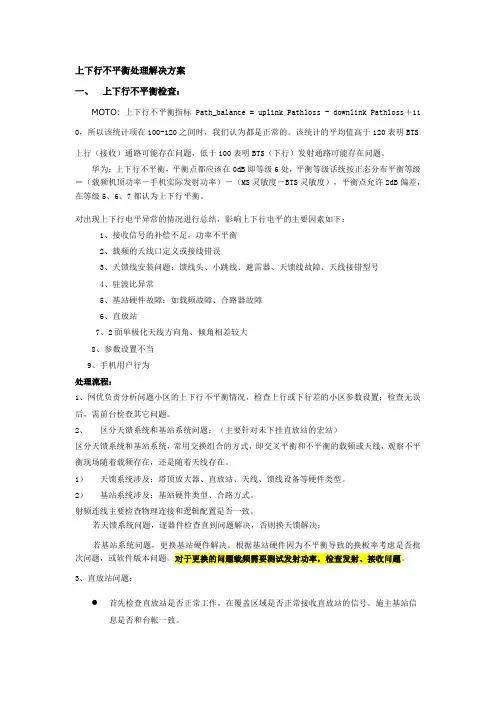
上下行不平衡处理解决方案一、上下行不平衡检查:MOTO:上下行不平衡指标 Path_balance = uplink Pathloss - downlink Pathloss+11 0,所以该统计项在100-120之间时,我们认为都是正常的。
该统计的平均值高于120表明BTS 上行(接收)通路可能存在问题,低于100表明BTS(下行)发射通路可能存在问题。
华为:上下行不平衡,平衡点都应该在0dB即等级6处,平衡等级话统按正态分布平衡等级=(载频机顶功率-手机实际发射功率)-(MS灵敏度-BTS灵敏度),平衡点允许2dB偏差,在等级5、6、7都认为上下行平衡。
对出现上下行电平异常的情况进行总结,影响上下行电平的主要因素如下:1、接收信号的补偿不足,功率不平衡2、载频的天线口定义或接线错误3、天馈线安装问题:馈线头、小跳线、避雷器、天馈线故障、天线接错型号4、驻波比异常5、基站硬件故障:如载频故障、合路器故障6、直放站7、2面单极化天线方向角、倾角相差较大8、参数设置不当9、手机用户行为处理流程:1、网优负责分析问题小区的上下行不平衡情况,检查上行或下行差的小区参数设置;检查无误后,需前台检查其它问题。
2、区分天馈系统和基站系统问题:(主要针对未下挂直放站的宏站)区分天馈系统和基站系统,常用交换组合的方式,即交叉平衡和不平衡的载频或天线,观察不平衡现场随着载频存在,还是随着天线存在。
1)天馈系统涉及:塔顶放大器、直放站、天线、馈线设备等硬件类型。
2)基站系统涉及:基站硬件类型、合路方式。
射频连线主要检查物理连接和逻辑配置是否一致。
若天馈系统问题,逐器件检查直到问题解决,否则换天馈解决;若基站系统问题,更换基站硬件解决。
根据基站硬件因为不平衡导致的换板率考虑是否批次问题,或软件版本问题。
对于更换的问题载频需要测试发射功率,检查发射、接收问题。
3、直放站问题:首先检查直放站是否正常工作,在覆盖区域是否正常接收直放站的信号。
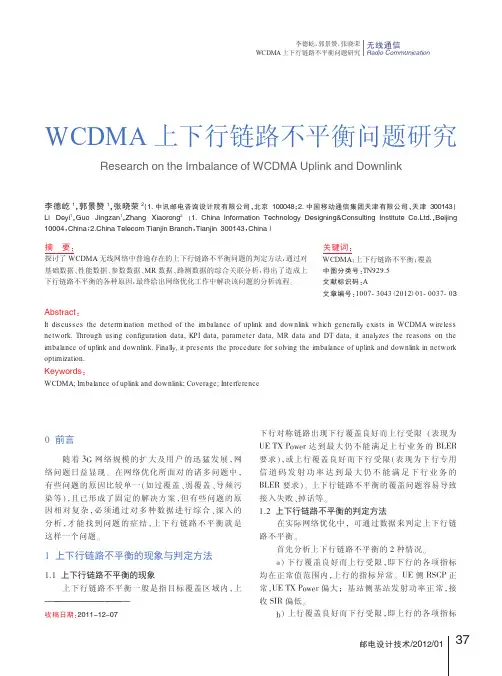
广州分公司-上下行链路不平衡优化改善用户VoLTE通话感知案例2019年9月目录一、问题描述 (1)二、问题分析 (1)(1)告警核查 (2)(2)干扰核查 (2)(3)覆盖核查 (2)(4)指标分析 (3)(5)现场CQT测试 (3)三、解决方案 (3)(1)优化思路和方法 (3)(2)效果验证 (3)四、经验总结 (5)【摘要】本案例以黄村荔院LTE-RRU06GZV2347高质差小区整治为例,研究分析发现,该小区因UE功率余量为负,存在上下行链路不平衡问题,从而导致数据传输过程中丢包严重,大大影响VoLTE质差。
通过FDD PDCP SDU丢弃定时器参数调整,以取得良好的VoLTE上行丢包率和感知的平衡,降低丢包率,有效改善了问题小区性能指标和用户VoLTE通话感知。
【关键字】UE功率余量、上下行链路不平衡、FDD PDCP SDU丢弃定时器【业务类别】参数优化一、问题描述该问题小区周边环境如下图所示,主要覆盖区域有高速、商务区等场景。
二、问题分析核查该小区告警情况,问题小区在4月4至4月10日未存在影响小区业务的重要告警。
(2)干扰核查(3)覆盖核查通过统计问题小区大于等于-110dBm的覆盖率在93%以上,不存在弱覆盖。
UE功率余UE功率余量(power headroom),简称PH。
无线信号从发送端到接收端存在能量损耗,power headroom =UE最大传输功率-PUSCH功率 =P max-P PUSCH●如果功率余量为正:表示UE在最大传输功率下,还能传输更多数据;●如果功率余量为负:表示UE的传输已经超过了允许的最大传输功率。
(4)指标分析(5)现场CQT测试①测试指标情况如下:现场对问题小区进行CQT定点锁频测试,MOS均值3.76,整体分析小结:该质差小区在无告警、覆盖良好的情况下,存在上下行链路不平衡导致上行RTP丢包,从而出现VoLTE通话质差。
三、解决方案(1)优化思路和方法结合指标分析与现场测试,优化措施如下:1、修改小区RS功率由21.2改为18.2,控制覆盖;2、问题小区的FDD PDCP SDU的丢弃时间(QCI1和QCI2)由100ms改为300ms。
如何解决上下行不平衡问题解释一下链路不平衡的问题“GSM中有一个参数为Path_balance值,这个值定义的即是链路平衡情况:上行损耗-下行损耗+110。
当上下链路平衡时,Path_balance值为110。
当下行损耗过大多半为驻波偏大引起,典型表现为系统通话质量变差,覆盖范围减小,系统容量变低,切换困难等,通话质量低了引起掉话也会有的,因为GSM参数中有一个移动台最小接入电平设置。
通常取-110dB,低于这个值便会引起掉话。
基站接收和移动台接收都有一定的灵敏度,只有当上行信号和下行信号分别达到基站和移动台所能接受的小的电平值时,才能正常收发。
当上行不能满足或者下行不能满足时,必然会有问题出现。
当在小区边缘时,上行满足下行不满足,可能会出现的情况是手机显示没有信号或者信号很弱。
当下行满足上行不满足时,可能出现的情况是手机信号很好(MS显示信号满格),但是手机拨电话很难拨,即使拨出去,也很容易掉话。
除掉话问题以外上下行不平衡也是产生单通的现象(这也就是你可以在手机里听到人家说话,但是你说的话别人听不见或者别人能够听见你讲话,但是你听不见别人讲话)的原因之一。
对于完全相同的路径,由于频段的不同,衰耗肯定不同,所以上下行不平衡是肯定的。
我认为一般上行加塔放,下行加大功率再加上调整天线就可以了,再不只能调整参数,不过如果基站没问题的话说实话没太大作用塔放确实是解决上行问题的好办法。
其实这个问题根治还真不大容易,只能尽量了。
P-b值是反映RTF性能的一个参数,它的计算公式为pathbalance=uplink pathloss-downlink path loss+110,故它的最佳值应为110。
P-b值不正常是在基站维护过程中经常遇到的问题,它会影响到拥塞、掉话等一些敏感的指标,也会造成通话质量的下降。
第一部分:造成P-b值不正常的原因造成P-b值不正常的原因有很多,既有软件方面的,也有硬件方面的。
总结起来主要有以下几个方面:1.基站数据定义错误2.话务量太低也会造成P-b值不正常3.相邻小区或本小区同频或邻频干扰也会造成P-b值不正常4.射频通路、接收通路硬件故障及连接错误5.载频本身故障6.带外干扰第二部分:解决P-b问题的步骤我们知道了造成P-b值不正常的原因,因此先不要急于下站,我们可以先进行一下前期的分析。
网络性能KPI(上下行不平衡)优化手册目录1 上下行链路平衡定义说明 (3)1.1 上下行平衡定义 (3)1.2 上下行平衡公式 (3)1.3 上下行不平衡定义标准 (3)1.4 上下行不平衡影响因素 (4)2 上下行链路不平衡处理流程 (5)3 上下行链路不平衡问题处理思路 (6)3.1 参数及数据配置不当 (6)3.2 硬件故障 (6)3.3 直放站及室分系统 (7)3.4 天馈线及跳线问题 (8)3.5 塔放安装 (8)3.6 天线匹配方面 (8)3.7 扩减容后连线问题 (9)3.8 手机用户行为 (9)4 上下行链路不平衡小区典型案例(具体分为11种类型): (9)4.1 案例一:数据与物理连线不一致 (9)4.2 案例二:TRX硬件隐行故障 (11)4.3 案例三:跳线故障 (12)4.4 案例四:室分系统或直放站 (14)4.5 案例五:TRX硬件故障 (16)4.6 案例六:驻波过高 (18)4.7 案例七:DDPU硬件问题 (19)4.8 案例八:减容后出现问题 (21)4.9 案例九:功率设置 (22)4.10 案例十:天馈接反 (24)4.11 案例十一:载频异常吊死导致上下行链路不平衡 (27)1上下行链路平衡定义说明1.1上下行平衡定义GSM系统是一个双向通信系统,上行链路和下行链路都有自己的发射功率和路径衰落,为了使系统工作在最佳状态,就要保证每个小区的链路达到基本平衡(上下行链路平衡),可以促使切换和呼叫建立期间,XX通话性能更好。
当上下行平衡时,上行、下行允许的最大传输路径损耗应该是相同的,可以促使切换和呼叫建立期间,XX通话性能更好: 下行链路(DownLink)是指基站发,XX台接收的链路。
上行链路(UpLink)是指XX台发,基站接收的链路。
上下行平衡,简言之,在下行信号达到边界时,上行信号也同时达到边界。
1.2上下行平衡公式根据测量报告上下行平衡测量<载频>提取出1-11级指标来计算各个等级的比例:上下行链路等级1的比例=上下行链路等级1的测量值/上下行链路等级1-11级的测量值上下行链路等级11的比例=上下行链路等级11的测量值/上下行链路等级1-11级的测量值1.3上下行不平衡定义标准华为总部定义上下行不平衡标准为:上下行平衡等级1的比例大于等于30% 则认为不平衡(下行偏弱或上行偏强)上下行平衡等级11的比例大于等于 30% 则认为不平衡(下行偏强或上行偏弱)主要的因素有:天馈线及跳线问题 塔放安装参数及数据配置不当 硬件故障直放站天线匹配方面扩减容后连线问题 手机用户行为3上下行链路不平衡问题处理思路3.1参数及数据配置不当这里涉及的上下电平的参数,主要是有:1)塔放衰减因子,2)MS 最大发射功率,3)功率等级塔放衰减因子:基站安装塔放后,一般上行都会带来上行增益,因此要设置“塔放衰减因子”。
无线信号根据传播方向分为上行和下行两个方向,在理想情况下上下行链路是平衡的,考虑到BTS接收灵敏度比MS稍高,上行信号允许稍弱。
即在任何区域基站侧和手机侧均可以同时收到对方的信号,或者同时无法收到对方的信号。
由于无线信号传播路径的不确定性以及实际环境的差异,在整网范围内完全实现无线链路上下行平衡是不可能的。
因此网络中必然存在下行信号可以覆盖而上行信号无法覆盖到的区域,在这些区域内,用户可以收到网络侧的消息而网络侧无法收到用户手机上报的消息,包括寻呼响应。
因此在这些区域内也很容易出现用户已出服务区的现象。
对于这种情况的用户已出服务区现象,首先可以通过调整无线参数,“RACH忙门限”、“RACH错误门限”、“MS最小接入电平”、“RSSI校正”等值来优化上下行平衡关系。
1、上下行不平衡或上行接收灵敏度低问题原因:当下行覆盖范围大于上行。
在小区边缘将产生伪覆盖区;在伪覆盖区内手机能够正常接收基站的信号,但是无法接入系统。
用户做主叫无法获得服务,作被叫时,就会出现不在服务区现象。
定位手段:话统中的“功率控制性能测量”、“上下行平衡性能测量”等解决方法:a、检查工程安装质量;b、调整无线参数。
2、配置基站功率未考虑各种合路器插损的区别问题原因:例如:SCU的插损比CDU高3~4dB,如果配置载频功率等级数据时没有考虑到两者的区别,将会导致配置SCU的小区下行功率偏小,覆盖不良。
3、小区重选频繁导致用户做被叫出现不在服务区现象问题原因:小区重选过于频繁,会影响手机的接入性能。
定位手段:实地路测和拨打测试;解决方法:a、通过网络优化改善小区覆盖b、调整无线参数上下行不平衡,指目标覆盖区域内,上下行对称业务出现下行覆盖良好而上行覆盖受限(如UE的发射功率达到最大仍不能满足上行BLER要求),或上行覆盖良好而下行覆盖受限(表现为下行专用信道码发射功率达到最大仍不能满足下行BLER要求)的情况。
上下行不平衡的覆盖问题比较容易导致掉话。
1、WCDMA系统上行干扰根据3G PP协议的规定,NodeB都有检测RTWP(Received T otal Wideband Power)功能,NodeB的RTWP测量功能是我们发现WCDMA上行干扰一个重要手段。
要讨论WCDMA系统的上行干扰,首先需要清楚RTWP的概念,下面对RTWP在空载和有负载情况下进行分析。
在空载情况下,由于热噪声的频谱密度为:-174dBm/Hz,在WCDMA的3.84MHz带宽内底噪约为-108dBm/3.84MHz;所以在空载下如果WCDMA系统上行没有受到干扰,假设基站的噪声系数为 2.5dB,则RTWP正常值为-105.5dBm/3.84MHz。
在上行有负载情况下,假设上行Interference Margin为3dB(在上行为50%负载情况下),如果WCDMA系统上行没有受到干扰,假设基站的噪声系数为2.5dB,则RTWP正常值为-102.5dBm/3.84MHz。
华为公司相关后台软件能够实时跟踪并以图形的形式显示RTWP数据,也可以把跟踪的数据文件通过华为公司自己开发的相关软件进行图形化显示。
图1是图形化显示的RTWP跟踪结果,在图1中红色代表这个小区对应的主集,蓝色代表这个小区对应的分集,横坐标表示一天的时间,单位为小时,纵坐标表示RTWP值,单位为dBm。
从图1可以看出,图1中左边的小区没有受到干扰,右边的小区受到比较强的干扰。
图1 两个小区的RTWP跟踪结果2.2 WCDMA系统上行主要干扰的分类WCDMA系统上行异常干扰可以分为系统内部和外部因素引起的干扰,本文把系统内部因素引起的干扰称为内部干扰,系统外部因素引起的干扰称为外部干扰。
根据华为公司WCDMA系统商用网络的干扰定位经验,系统内部干扰可能是由于工程质量问题引起的,如天馈、连接器和负载等接头引起的干扰,也可能是由于天线、连接器和负载等器件本身的质量问题引起的干扰;系统外部干扰主要指外界的干扰源引起或外界干扰源与系统内部相互作用后引起的干扰,根据华为公司WCDMA系统商用网络的干扰定位经验,外部干扰源可能是已存在的2G系统、直放站、手机干扰器、微波传输设备和非法使用WCDMA系统工作频段的发射设备等引起的干扰。